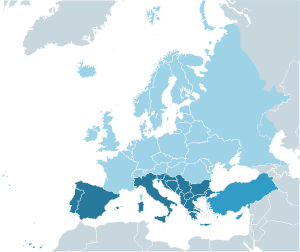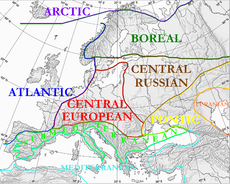- Southern Europe
-
The term Southern Europe, at its most general definition, is used to mean "all countries in the south of Europe". However, the concept, at different times, has had different meanings, providing additional political, linguistic and cultural context to the definition in addition to the typical geographical, phytogeographic or climatic approach. Most coastal countries in the United Nations-designated southern Europe border the Mediterranean Sea. Exceptions are Portugal which has only Atlantic coastline, Serbia and the Republic of Macedonia, which are landlocked, and Bulgaria, which borders the Black Sea.
Contents
Geographical definition
Geographically, southern Europe is the southern half of the landmass of Europe. This definition is relative, with no clear limits.
Countries geographically considered part of southern Europe include:
Iberian Peninsula
 Andorra
Andorra Gibraltar (British overseas territory)
Gibraltar (British overseas territory) Portugal (including: Madeira and Azores)
Portugal (including: Madeira and Azores) Spain (including: Balearic Islands)
Spain (including: Balearic Islands)
Italian Peninsula
 Italy (including: Sardinia and Sicily)
Italy (including: Sardinia and Sicily) San Marino
San Marino Vatican City
Vatican City
Balkans
 Albania
Albania Bosnia and Herzegovina
Bosnia and Herzegovina Bulgaria
Bulgaria Croatia (below Sava and Kupa)
Croatia (below Sava and Kupa) Greece (including: Aegean Islands, Crete, and Ionian Islands)
Greece (including: Aegean Islands, Crete, and Ionian Islands) Macedonia
Macedonia Montenegro
Montenegro Serbia (below Sava and Danube)
Serbia (below Sava and Danube)
 Turkey (East Thrace)
Turkey (East Thrace)
Other
 Croatia (northern regions (Slavonia, Zagreb, Međimurje and Zagorje) are sometimes considered as Central Europe)
Croatia (northern regions (Slavonia, Zagreb, Međimurje and Zagorje) are sometimes considered as Central Europe) Cyprus (geographically part of Asia but considered European for historic and cultural reasons)
Cyprus (geographically part of Asia but considered European for historic and cultural reasons) Malta (including: Gozo)
Malta (including: Gozo) Romania (Northern Dobruja is considered Southern European and sometimes Wallachia. Transylvania is sometimes considered as Central Europe)
Romania (Northern Dobruja is considered Southern European and sometimes Wallachia. Transylvania is sometimes considered as Central Europe) Serbia (northern regions (Vojvodina, northern Belgrade, Mačva region) are sometimes considered as Central Europe)
Serbia (northern regions (Vojvodina, northern Belgrade, Mačva region) are sometimes considered as Central Europe) Slovenia (region of Primorska)
Slovenia (region of Primorska)
United Nations geoscheme

For its official works and publications, the United Nations Organization groups countries under a classification of regions. Southern Europe, as defined by the United Nations (the sub-regions according to the UN), comprises the following countries and territories:[1]
 Albania
Albania Andorra
Andorra Bosnia and Herzegovina
Bosnia and Herzegovina Croatia
Croatia Gibraltar (can be included in Western Europe politically as it is a territory of the
Gibraltar (can be included in Western Europe politically as it is a territory of the  United Kingdom)
United Kingdom) Greece (including: Aegean Islands, Crete, and Ionian Islands)
Greece (including: Aegean Islands, Crete, and Ionian Islands) Italy (including: Sardinia and Sicily)
Italy (including: Sardinia and Sicily) Macedonia
Macedonia Malta (including: Gozo)
Malta (including: Gozo) Montenegro
Montenegro Portugal (including: Madeira and Azores)
Portugal (including: Madeira and Azores) San Marino
San Marino Serbia
Serbia Slovenia
Slovenia Spain (including: Balearic Islands)
Spain (including: Balearic Islands) Vatican City
Vatican City
As of 2009, there were 163,865,210 people living in Southern Europe with an average population density of 74 inhabitants per square kilometer:[1]
Southern Europe:[1] Country Area
(km²)Population
(2010 est.)Population density
(per km²)Capital  Albania
Albania28,748 3,695,000 111.1 Tirana  Andorra
Andorra467.63 84,082 179.8 Andorra la Vella  Bosnia and Herzegovina
Bosnia and Herzegovina51,129 4,613,414 90.2 Sarajevo  Croatia
Croatia56,594 4,489,409 81 Zagreb  Gibraltar (United Kingdom)
Gibraltar (United Kingdom)6.8 29,431 4,328 Gibraltar  Greece
Greece131,990 11,295,002 85.3 Athens  Italy
Italy301,338 60,418,711 200.5 Rome  Republic of Macedonia
Republic of Macedonia25,713 2,114,550 82.2 Skopje  Malta
Malta316 412,966 1,306.8 Valletta  Montenegro
Montenegro13,812 672,181 50 Podgorica  Portugal
Portugal92,090 11,317,192 114 Lisbon  San Marino
San Marino61.2 31,716 501 City of San Marino  Serbia
Serbia88,361 7,306,677 107.46 Belgrade  Slovenia
Slovenia20,273 2,054,199 99.6 Ljubljana  Spain
Spain504,030 46,030,109 93 Madrid  Vatican City
Vatican City0.44 826 1877 Vatican City Total 1,338,694 163,865,210 74.05 Climatical definition
Southern Europe's most emblematic climate is that of the Mediterranean climate, which has become a typically known characteristic of the area. The humid subtropical climate is a southern european climate too (Northern Italy, Bulgaria...).
Those areas of Mediterranean climate present similar vegetations and landscapes throughout, including dry hills, small plains, pine forests and olive trees.
The area which is considered climatically Southern Europe is:
 Albania
Albania Bosnia and Herzegovina (coasts)
Bosnia and Herzegovina (coasts) Croatia (coasts)
Croatia (coasts) Cyprus
Cyprus France (southeast coast, and the island of Corsica)
France (southeast coast, and the island of Corsica) Gibraltar
Gibraltar Greece
Greece Italy (except the Po River plain and Alps region)
Italy (except the Po River plain and Alps region) Kosovo
Kosovo Macedonia
Macedonia Malta
Malta Monaco
Monaco Montenegro
Montenegro Portugal[2]
Portugal[2] Serbia (south)[3]
Serbia (south)[3] Slovenia (coasts)
Slovenia (coasts) Spain (the whole of the country except the northern coast)
Spain (the whole of the country except the northern coast)
Phytogeographical definition
Southern Europe's flora is that of the Mediterranean Region, one of the phytochoria recognized by Armen Takhtajan. The Mediterranean and Submediterranean climate regions in Europe comprise the following countries and territories:[4]
 Albania
Albania Bosnia and Herzegovina
Bosnia and Herzegovina Bulgaria
Bulgaria Croatia
Croatia Cyprus
Cyprus France (the southern and southeastern part, and the island of Corsica)
France (the southern and southeastern part, and the island of Corsica) Greece (including: Aegean Islands, Crete, and Ionian Islands)
Greece (including: Aegean Islands, Crete, and Ionian Islands) Hungary (the southwestern part till the Lake Balaton)
Hungary (the southwestern part till the Lake Balaton) Italy
Italy Kosovo
Kosovo Macedonia
Macedonia Malta
Malta Montenegro
Montenegro Portugal
Portugal Romania (only the southern part along the Danube river)
Romania (only the southern part along the Danube river) Serbia
Serbia Slovenia
Slovenia Spain (except for the northwestern part)
Spain (except for the northwestern part) Switzerland (only Ticino)
Switzerland (only Ticino) Ukraine (only the southern part of Crimea)
Ukraine (only the southern part of Crimea)
Linguistic Southern Europe
Romance languages
Romance languages and modern Greek are the heirs of Latin and ancient Greek as the main historical languages of the Mediterranean area. Romance languages have spread from the Italian peninsula, and are emblematic of southern-western Europe: the "Latin Arch" (Romania and Moldova are an exception on that point); modern Greek is used in Greece and Cyprus.
 Andorra: Catalan
Andorra: Catalan France: French, Occitan, Franco-Provençal, Catalan, Corsican
France: French, Occitan, Franco-Provençal, Catalan, Corsican Italy: Italian, Friulian, Ladin, Sardinian, Catalan, Occitan, Franco-Provençal, plus the so-called "Italian dialects", not officially recognised by Italian Republic (Piedmontese, Ligurian, Lombard, Venetian, Emiliano and Romagnolo, Neapolitan, Sicilian)
Italy: Italian, Friulian, Ladin, Sardinian, Catalan, Occitan, Franco-Provençal, plus the so-called "Italian dialects", not officially recognised by Italian Republic (Piedmontese, Ligurian, Lombard, Venetian, Emiliano and Romagnolo, Neapolitan, Sicilian) Moldova: Romanian
Moldova: Romanian Monaco: French, Monégasque
Monaco: French, Monégasque Portugal: Portuguese, Mirandese
Portugal: Portuguese, Mirandese Romania: Romanian
Romania: Romanian San Marino: Italian
San Marino: Italian Spain: Spanish, Catalan, Galician (plus Aragonese, Asturian, Leonese, Extremaduran)
Spain: Spanish, Catalan, Galician (plus Aragonese, Asturian, Leonese, Extremaduran) Switzerland: French, Italian, Romansh
Switzerland: French, Italian, Romansh Vatican City: Italian
Vatican City: Italian
Greek language
 Albania: Himariote
Albania: Himariote Cyprus: Cypriot Greek
Cyprus: Cypriot Greek Greece: Cappadocian, Cretan, Maniot, Pontic, Tsakonian, Romano-Greek, Yevanic
Greece: Cappadocian, Cretan, Maniot, Pontic, Tsakonian, Romano-Greek, Yevanic Italy: Griko
Italy: Griko Turkey: Pontic
Turkey: Pontic Ukraine: Crimean Greek
Ukraine: Crimean Greek
Albanian language
Albanian is also a language rooted in southern Europe, spoken in the Balkan peninsula.
Gheg:
Tosk:
South Slavic languages
Slavic languages that are now spoken in southern Europe are not rooted in the Mediterranean area nor spoken mainly in those areas: In that sense those languages are not part of the linguistic definition of southern Europe, since they are logically associated with their "core". That said, southern Slavic languages form a quite homogenous area, geographically separated from north Slavic languages by Hungary and Romania.
 Bosnia and Herzegovina: Bosnian, Croatian, Serbian
Bosnia and Herzegovina: Bosnian, Croatian, Serbian Bulgaria: Bulgarian
Bulgaria: Bulgarian Croatia: Croatian
Croatia: Croatian Macedonia: Macedonian
Macedonia: Macedonian Montenegro: Montenegrin, Serbian
Montenegro: Montenegrin, Serbian Serbia: Serbian
Serbia: Serbian Slovenia: Slovene
Slovenia: Slovene Italy: Slovene (in Eastern Friuli-Venezia Giulia)
Italy: Slovene (in Eastern Friuli-Venezia Giulia)
Germanic languages
Due to the English colonisation in Malta and Gibraltar, Germanic languages have a little presence in southern Europe, far from the core of Germanic languages in northwestern Europe. Malta uses English as a second language in some cases (after Maltese, which still is the original and main native language). In Gibraltar, English is the official language but Spanish and Llanito (mix of Andalusian, Spanish with some English) are also spoken.
 Gibraltar: English
Gibraltar: English Malta: English
Malta: English Italy: German (in South Tyrol and some small areas in the Northern part of the country)
Italy: German (in South Tyrol and some small areas in the Northern part of the country)
Semitic languages
Basque language
The Basque language is a linguistic isolate spoken by the Basque people, who inhabit the Basque Country, a region spanning an area in northeastern Spain and southwestern France.
See also
References
- ^ a b c United Nations Statistics Division- Standard Country and Area Codes Classifications (M49)
- ^ http://www.meteo.pt/pt/areaeducativa/otempo.eoclima/clima.pt/index.html
- ^ World Factbook
- ^ Wolfgang Frey and Rainer Lösch; Lehrbuch der Geobotanik. Pflanze und Vegetation in Raum und Zeit. Spektrum Akademischer Verlag, München 2004
Regions of the world 
Africa Northern · Sub-Saharan (Central · Southern · Western · Eastern) 
Oceania Australasia (Australia) · Melanesia · Micronesia · Polynesia 
America North (Northern • Middle • Central • Caribbean) · South (Southern • Northern • Western) · Anglo · Latin 
Polar Arctic · Antarctic 
Asia Central · Eastern (Northeastern) · Northern · Southeastern · Southern (Indian subcontinent) · Western (Middle East) 
Oceans World · Arctic · Atlantic · Indian · Pacific · Southern 
Europe Central · Eastern · Northern · Southeastern · Southern · Western 
Seas List of seas Related Continents of the world · List of seas · Physical EarthCategories:
Wikimedia Foundation. 2010.


